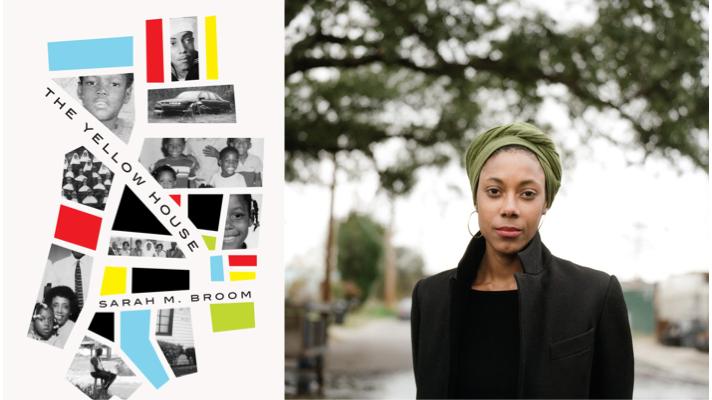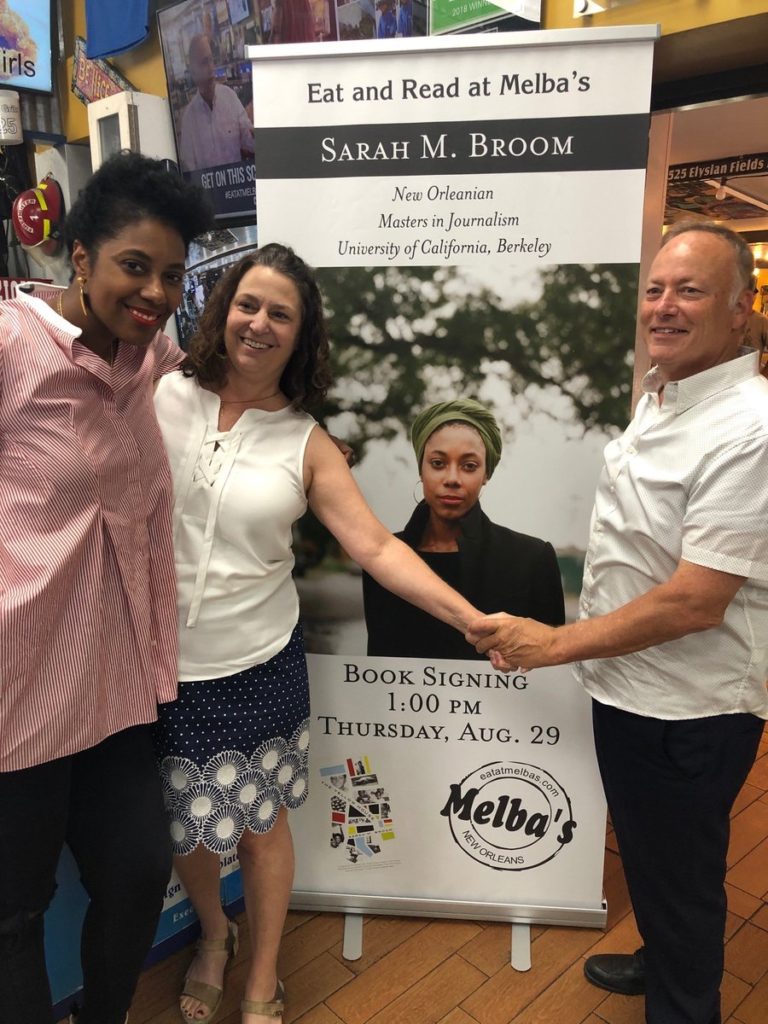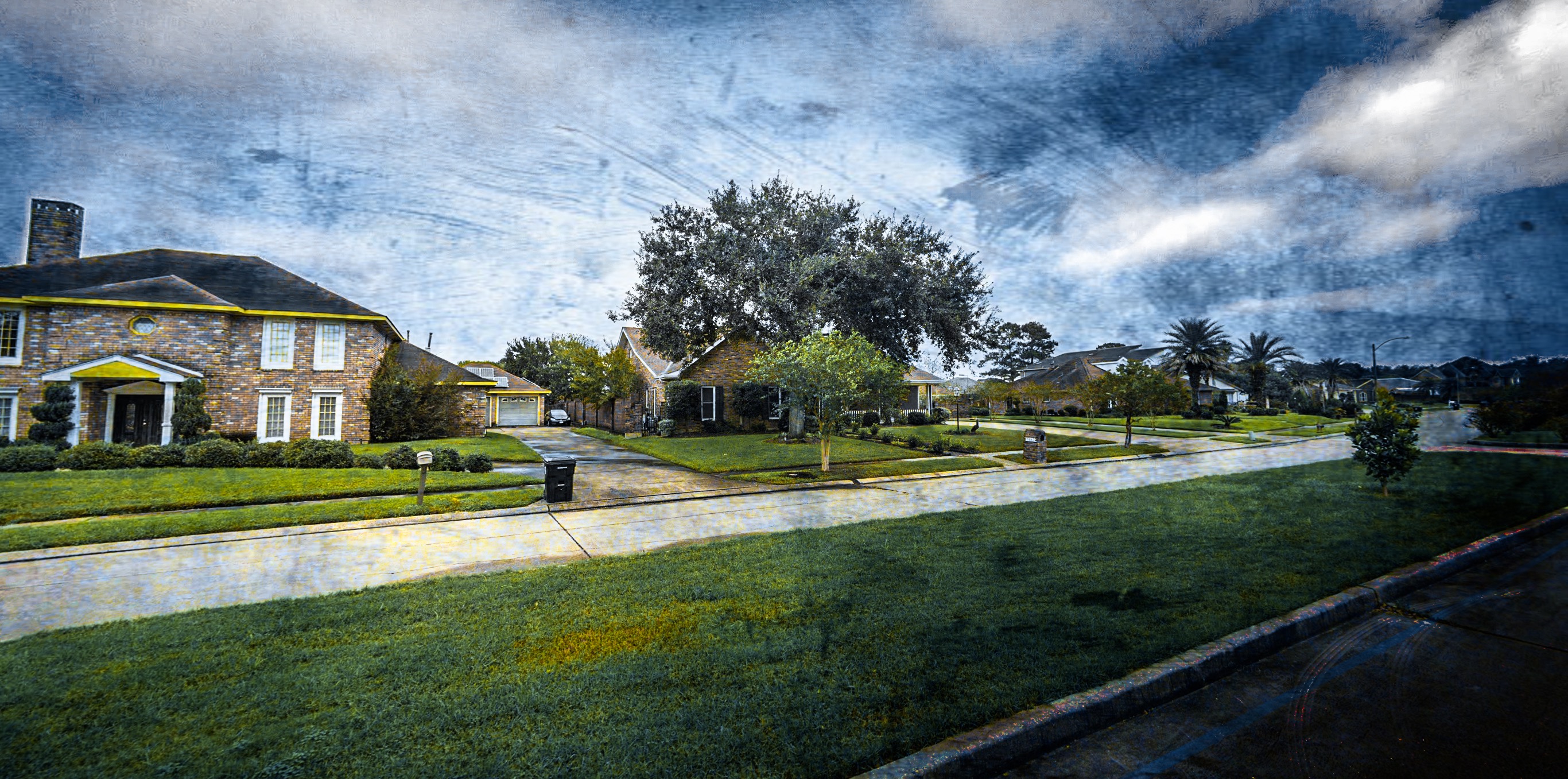Featured image: A boulevard of imposing homes in New Orleans East. Source: the Bayou Brief.
The yellow house – where author Sarah M. Broom grew up and for which she named her memoir, The Yellow House – used to be green, back when Broom’s mother, Ivory Mae, purchased it with insurance money from her first husband’s death.
A teenage widow and mother to three small boys, Ivory moved into the house in a pocket of New Orleans East wedged between railroad tracks, a trailer park, and a six-lane highway with her new husband Simon Broom and his two daughters.
Together, Ivory and Simon hosted parties, had seven more children, made unfinished additions to the then-green house, and danced on the lawn after dark.
Simon worked at the NASA plant, played trumpet and banjo at second lines, and made the family’s social calendar which included membership in the Pontchatrain Park Social Aid and Pleasure Club. The blended Webb and Broom family had a pleasant enough life when they welcomed the 12th child, the author, to whom they gave the name Monique Sarah Broom.
Six months after Broom’s birth, Simon died from a brain aneurysm and there ends the dynamism of the book.
Somehow, Broom changes names, schools, jobs, friends, churches, careers, cities, continents, but per her portrayal, she remains unchanged. She writes about experiencing anxiety created by her brother’s crack addiction, guilt for having not experienced Hurricane Katrina as a resident, sadness at the death of her childhood friend, sometimes noting journal entries she’d made at the time.
She writes about her emotions but portrays herself as inhumanly constant. The Yellow House reads like a book-long double-dolly shot, dissociative, both self-centered and lacking in self-awareness, shrouded in blurry context.

More than a month has passed since I first sat down to read The Yellow House, excited by a memoir about someone like me – a Black woman writer from New Orleans, the youngest of a large family, with family roots in Central City, who sees in Black women’s relationship to home a universality, an opportunity to connect people through stories about the shared human desire to belong.
But I found myself constantly extending the benefit of the doubt: when Broom misrepresents Black New Orleans vernacular, when she suggests that gold teeth are evidence of criminality, when she refers to Black children in the French Quarter as criminals.

The final straw landed when Broom gave away copies of the book at Melba’s, a white-owned restaurant and laundromat in a gentrifying 8th Ward that many Black New Orleanians have avoided since a manager, the owner’s brother, said they would not screen the football game if any players kneeled in protest of police violence.
I was less disturbed by her choice to partner with them (after all, she doesn’t live here and might not have known their history) than by the realization that hers is the kind of narrative people like the Melba’s owners can get behind, a story of Black exceptionalism that supports the benevolent racist belief that Black people just need to ‘pull ourselves up by the bootstraps’ (expressed by the Melba’s owner in this interview).
Broom grew up in New Orleans East at the height of the area’s prosperity. New Orleans East, to this day, houses quite a bit of Black wealth and political influence. But you wouldn’t know that from The Yellow House.
Broom depicts the East as slums, characterized by “junkyards, trailer parks, and flagrant prostitution” as New York Times critic Dwight Garner writes.
Though Broom sort of acknowledges in her use of the phrase “the short end of Wilson” throughout the book that the area in which she grew up is hardly representative of New Orleans East as a whole, she undermines that distinction by recounting interactions between her and Black New Orleanians from the other side of the canal meant to drive home the East’s supposed alienation from the rest of the city.
“Often, when I tell fellow natives that I am from New Orleans East,” she writes, “[T]hey will say, ‘Oh baby, don’t tell nobody that.’”
When people say she doesn’t have a New Orleans accent, Broom explains by saying she’s from New Orleans East. But her brothers who are also from New Orleans East have accents according to her own account.
In Broom’s New Orleans, the French Quarter dominates the geography, and the East is an afterthought at best. After receiving her advance to write the memoir, Broom returns to New Orleans and lives in the French Quarter to conduct research for her memoir.
Broom writes that she chooses to live in the French Quarter to centralize herself in the story of New Orleans.
“The farther out you are from the French Quarter,” she writes, “the less tended you would be.”
That’s not the way I experience the city.
Until its demolition in 2008, the Iberville public housing development was across the street from the French Quarter, the Lafitte was just blocks away.
Central City, one of the most under-resourced neighborhoods in the city with the highest rate of gun violence, is separated from the French Quarter by a walkable mile. Rampart Street divides the French Quarter from the historic Treme neighborhood, part of which was demolished by imminent domain to build a community center that never came into existence and Louis Armstrong Park.
Half a mile further into Treme lies the Interstate – which fertilized the East’s development by bridging the two sides of the Industrial Canal when it was built atop the remains of black-owned homes, businesses, and Oak Tree-filled neutral ground.
Next to the interstate is University Medical Center, the private hospital that unnecessarily replaced the minimally-damaged public hospital after Katrina. Eighty city blocks of homes that had been rebuilt after the storm were razed to build it. Developers now propose to make the former public hospital a massive AirBnB complex, with a few market and below-market rate residences.
Each of these Black and under-resourced neighborhoods is within walking distance from the French Quarter. Past all of them, much farther from the French Quarter than they are, lay wealthier, whiter neighborhoods like the Garden District, Lakeview, and Bayou St. John.
The geographic and cultural centrality of the French Quarter to the lived experiences of Black New Orleans, to determining how resources and life chances are distributed, is a figment of Broom’s imagination.
Broom’s questionable, if not outright false, social and historical analysis is compounded by her lack of self-awareness. Broom, in her steadfastness, is as impossible a character as sill on piers atop swampland is a foundation for a home: You can try it, but in the long run, it won’t hold up against the surge of reality.

It’d be one thing if Broom were the narrator of a novel – whose claim to objectivity or lack of self-reflection was just a character flaw that readers knowingly factor into their perception of the narrative. But this is memoir, Black memoir, the foundation of the Black American literary cannon laid by authors who, in the eyes of the law, were considered criminals, thieves of their own bodies, time, and labor.
In the genre of Black memoir, Broom’s attempt to appear staid, a flat, quasi-objective documentarian whose worst offense in life is having skipped school, challenges her credibility and amplifies the book’s analytical flaws.
Yes, urban planning has historically been and still is pretty freaking racist, but the isolation Broom attributes to urban planning seems mostly a result of her family dynamics – her mother’s social isolation following the death of Broom’s culturally-engaged father and the gap in age between Broom and her older siblings – than a result of New Orleans geographies.
Broom’s social and cultural isolation is her own, not the East’s, not everyone-who-lives-outside-the-French-Quarter’s. The home Broom writes is hers alone, and there’s nothing wrong with that, I suppose. I just wish she hadn’t tried to make it seem like she’s writing for a voiceless Black polity that, by and large, does not identify with her experience. The Yellow House left me wondering, what was the point?
This critique of urban planning that dovetails into a paternalistic chastisement of Black New Orleans for taking pride in our culture is not unique to Broom.
Tulane University academic Matt Sakakeeny and his Australia-based colleague Thomas Jessen Adams recently co-edited an anthology entitled Remaking New Orleans: Beyond Exceptionalism and Authenticity.
As explained in an Advocate op-ed, the editorial premise of Remaking New Orleans is that New Orleanians are more invested in preserving the veneer of cultural authenticity that drives racist economic development decisions than we are in combatting inequitable systems, like lack of quality public education and affordable housing.

Sakakeeny and Adams don’t explicitly refer to Black New Orleans but the cultural traditions that they describe as distractions – “creole cuisine, voodoo queens, and hot jazz” – are inarguably Black.
Our foodways, spiritual practices, and musical traditions share a primary purpose: to fortify relationships within our community through process and ritual.
Black New Orleans rests safely on the stilts of relationships. You are the family who chooses you, the schools you attend, the neighborhoods in which you grow up, the friends you run with. Within our families, at our schools, in our neighborhoods, we engage in the processes of relationship which leads to the products for which we are internationally renowned – our food, our spirituality, our music.
Broom writes that, in the aftermath of the Federal Flood, she realized the error in centering a place in one’s identity, but I disagree with the idea that that is an error.
Our choice to claim this place as part of our identity is a choice to honor our relationships, a practice that feels especially important in this post-Post-Katrina moment when New Orleans is being ‘remade’ by people who resent their lack of access to the social and political capital that comes with having gone through these processes. Our choice to claim this place as part of our identity is political, an act of civic engagement, a fortification of the relationships between Black people that it has been the primary task of white supremacy to dissolve.
As the city sinks and the water rises and the infrastructure fails and the newcomers call the cops on us for playing music where music has always been played, our relationships, which is to say our cultural integrity, buoy us up. There’s still time for Monique to grab on. I’m not so sure about Sarah though.

